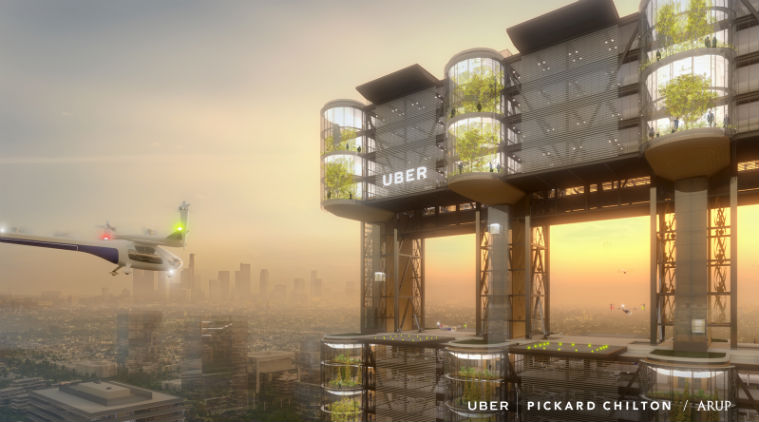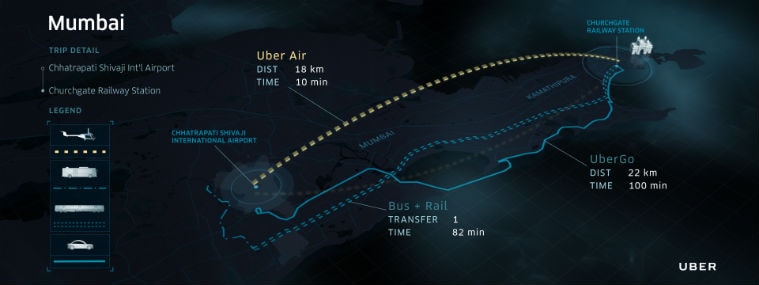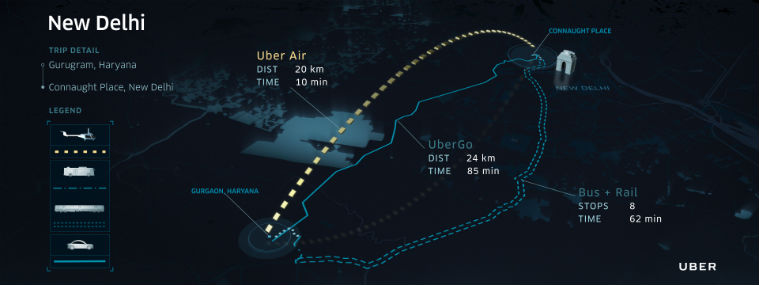 Uber to launch flight demonstrations of Uber Air in Dallas-Fort Worth/Frisco Texas and Los Angeles in 2020.
Uber to launch flight demonstrations of Uber Air in Dallas-Fort Worth/Frisco Texas and Los Angeles in 2020.
Imagine commuting from Mumbai airport to CST or from Gurgaon to Central Delhi in just 10 minutes. Well, that is exactly what Uber is envisioning for urban transport in the coming years with UberAir, its concept for urban air mobility. On Thursday, Uber announced India as one of the five countries shortlisted for its air mobility solution along with Japan, France, Australia, and Brazil. One city from this shortlist could end up being the third location where Uber Air flights will take to the skies — Dallas and Los Angeles were the first two cities named.
While Uber launched its Elevate programme in 2016, last year the ride-sharing company announced its intention to launch flight demonstrations of UberAir in Dallas-Fort Worth/Frisco Texas and Los Angeles in 2020 with commercially trips starting as early as 2023. At the Uber Elevate Asia-Pacific summit in Tokyo on Thursday, the ride-sharing company reiterated that it was looking beyond cars to solve the problem of congestion in the fast-growing urban areas across the world.
Eric Allison, head of Aviation Programmes at Uber, said in pursuit of its first international launch market, where you will be able to push a button and get a flight, Uber is announcing a shortlist of five countries where UberAir can immediately transform transportation and take our technology to new heights. Uber Elevate has also designed and released the first example of future routes for Uber Air flights for Delhi, Tokyo, Mumbai, Seoul, Sydney, and Taipei. Uber suggests that just in Delhi NCR Uber Air will be able to save about two hours every day for commuters.
Nikhil Goel, Uber’s head of product for aviation, said congestion in Indian cities adds up to $22 billion every year. He said Uber will be meeting policy makers in Delhi in the coming weeks to take this forward.
Uber Chief Operating Officer Barney Harford said his company was no longer about just cars but would be an urban mobility player in every sense of the term. “Uber is looking to the sky to unlock new opportunities for urban residents,” he said, calling it the boldest step to radically improve urban transportation.
 Uber Elevate has also designed and released the first example of future routes for Uber Air flights for Delhi, Tokyo, Mumbai, Seoul, Sydney, and Taipei.
Uber Elevate has also designed and released the first example of future routes for Uber Air flights for Delhi, Tokyo, Mumbai, Seoul, Sydney, and Taipei.
Uber is working with multiple partners to help with technology for developing aircraft and infrastructure for trips within a range of 15 and 100 km. “We are looking at an entirely new type of aircraft that is electric, takes off and lands vertically and flies at speeds of up to 300 km per hour. These new aircraft will offer incredible speed and high reliability,” Hardford said. These aircraft will maintain a cruising altitude of 1000-2000 feet and be able to do trips of up to 60 miles on a single charge. He said the price of these aerial trips will go below car ownership and will thus be a mass product in every way.
 Uber suggests that just in Delhi NCR Uber Air will be able to save about two hours every day for commuters.
Uber suggests that just in Delhi NCR Uber Air will be able to save about two hours every day for commuters.
Hardford also announced that Uber’s vision for the skies was not just limited to transporting people, but also things. “Uber is actively testing small aerial vehicles for delivery of food and other products. Uber will be a one-stop-shop for moving people and things,” he added. As a spinoff, Uber Eats will take to air to increase the speed and reach of its food delivery business.
To unlock the real potential of cities, Allison said, we will need to look to the skies. Underlining how urban air travel “changes rules of the game”, he said: “Ground networks are path based, but aerial is node-based. So adding a new node gives access to all the previous ones and this changes everything,” he explained.
Allison said while Uber experimented with helicopters, it became clear that the solution had to be quieter, cheaper and safer to be successful. He said aircraft manufacturers who are developing electric VTOL (vertical take off and landing) vehicles, including Embraer, Bell, Boeing subsidiary Aurora Flight Sciences, Pipistrel Aircraft and Karem will collectively invest billions of dollars in making these aircraft a reality. Architectural partners are already working models for mega skyports which will be able to organise the trips as well as allow for charging and maintenance of the aircraft.
Tokyo is exploring air mobility as a solution to be made available in time for the Olympics in 2020. Tokyo Governor Yuriko Koike said she looks forward to seeing flying cars in the urban sky. Other government officials confirmed that they were looking to see a roadmap by end of the year so that the countries take the lead in this state of the art technology.
The author is attending the Uber Elevate summit on the invite of Uber India.